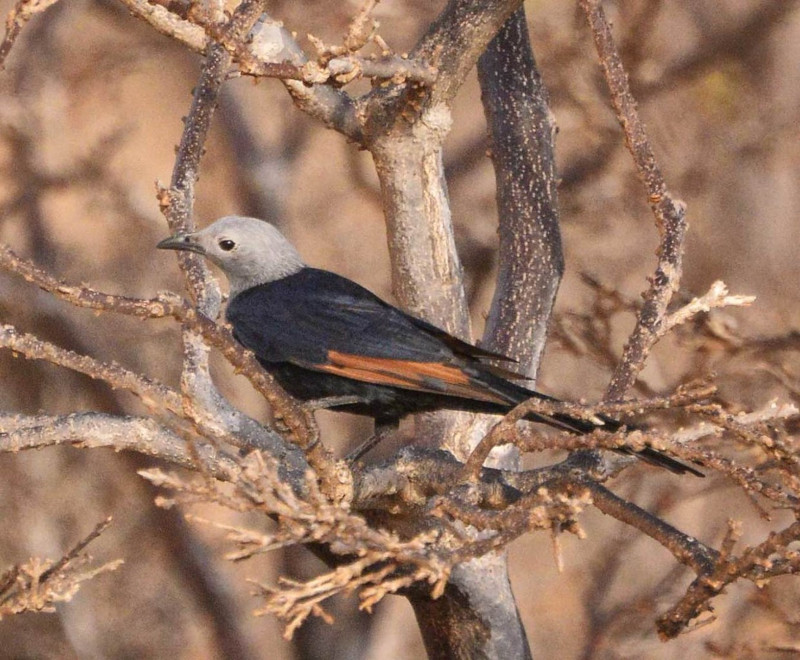Socotra Starling Facts
- The term of Socotra Starling serves as the most frequently employed common name for this intriguing variety of winged wonder. It does have other general titles, though, in different languages. These include Estornino de Socotora and Sokotrastar, among others.
- Within the scientific community, however, it’s perhaps better known by its technical designation. That moniker, unfortunately, as so often holds true, is extremely difficult for the layperson to pronounce. That’s because it bears the formal tag of Onychognathus frater.
- The avian received that appellation due to the combined efforts of a respected team of researchers. That group consisted of the duo of the British ornithologist Philip Lutley Sclater, and the German ornithologist Gustav Hartlaub. They recognized it as a separate species in 1881.
- Fortunately, the amazing Socotra Starling seems to be maintaining both a stable and sufficient population base. That pleasant state also appears to hold across its entire range. The IUCN thus currently shows the creature as Least Concern on its Red List of Threatened Species.
- However, that status shouldn’t be taken for granted. Its natural territory remains quite limited, for one consideration. It also faces mulitple threats to its continued existence as a species. Like all forms of life, it’s endangered by potential habitat loss and ongoing climate change.
Related Articles
Socotra Starling Physical Description
The fascinating Socotra Starling typically captivates those individuals fortunate enough to enconter one of these marvels of Nature. This usually occurs, however, due more to its appearance than any aspect of its size. That’s true since, in this regard, it ranks as a roughly medium-sized bird.
This winged wonder distinguishes itself from others around in the world in one surprising way. Unlike most birds, it displays almost no visible degree of the physiological characteristic of sexual dimorphism. What little it does manifest presents in males being only slightly larger.
Otherwise, the two genders present roughly the same general outward appearance to the observer. Fully mature adults attain total lengths averaging between 10 – 11 in (25 – 27 cm). Though exceptional individuals do occasionally occur, these rarely exceed this length by any great amount.
The many short feathers covering the head of the bird present a grayish-white coloring. Its bill, meanwhile, evolved as relatively short and stout, and entirely black in color. The eyes remain dark, often appearing as deep brown or black, which contrasts sharply with the glossy black feathers.
It’s the primary plumage, though, of the Socotra Starling that usually garner the most attention. The animal has a glossy black plumage. Its feathers exhibit a purplish or bluish sheen, especially in sunlight. The wings also show black, and sometimes a slightly brownish tinge towards the edges.
Its tail, however, develops as relatively long and square-tipped, also black, maintaining the glossy sheen seen in the rest of the body. The legs and feet of this marvelous creation of Nature and evolution, though, present a deep black, complementing the bird’s overall dark appearance.
- Kingdom: Animalia
- Phylum: Chordata
- Class: Aves
- Order: Passeriformes
- Family: Sturnidae
- Genus: Onychognathus
- Species: O. frater
Socotra Starling Distribution, Habitat, and Ecology
The tantalizing Socotra Starling evolved as indigenous to an extremely restricted section of the surface of the earth. The exact location of that zone of habitation, however, won’t come as a surprise to anyone. That’s because it’s implied in the very name of this remarkable work of evolution.
As given in that title, the lovely little bird apparently developed as native solely to the island of Socotra. That body itself lies in the Arabian Sea, off the horn of Africa. Due its isolation, no evidence currently exists that the natural wonder ever appeared naturally anywhere else on the planet.
Thankfully, Nature blessed the creature with an impressive flexibility regarding its choice of habitat. The animal’s therefore seen in a moderately wide variety of ecosystems across the island. These regions essentially include any such which provide the necessary resources for its survival.
It’s frequently found in the island’s woodland areas, particularly where there frankincense trees and other native flora appear in abundance. It’s also found in the more arid, scrub-covered parts of the island. These areas contain scattered shrubs and bushes, which provide both food and cover.
The bird also favors the higher elevations of the island, including its mountains and rocky areas. These regions provide shelter and vantage points for the birds, as well as nesting crevices in the rocky outcrops. It’s even sometimes seen inhabiting areas in the proximity of human habitations.
Like most birds, it evolved as an omnivore. The avian feeds on a variety of sources. It consumes fruits, seeds, and insects, making use of the diverse flora and fauna available on the island. It’s typically seen foraging in woodlands and scrublands, often feeding on the ground or in trees.
As a fruit-eater, this marvel of Nature contributes to the dispersal of many types of seeds, aiding in the regeneration of vegetation across the island. By feeding on insects, the bird additionally helps control insect populations, which also benefits the overall health of the ecosystem.
The Socotra Starling nests in rocky crevices, cliffs, and sometimes in trees. Its choice of nesting sites often provides protection from predators and harsh weather conditions. Data about its breeding season remains scarce, but this likely has a link to increased food supply and seasonal rains.
It’s also often observed in small flocks, indicating a social structure that may be important for foraging and predator avoidance. The intriguing species further remains known for its vocalizations, which play a role in social interactions within flocks, as well as in various territorial displays.
Species Sharing Its Range
Check out our other articles on 5 Geological Wonders of Australia, Eurasian Red Squirrel, Mammoth Hot Springs, Lehua Tree, Jack Jumper Ant, Tiger Shark, Harpy Eagle, Alligator Snapping Turtle

